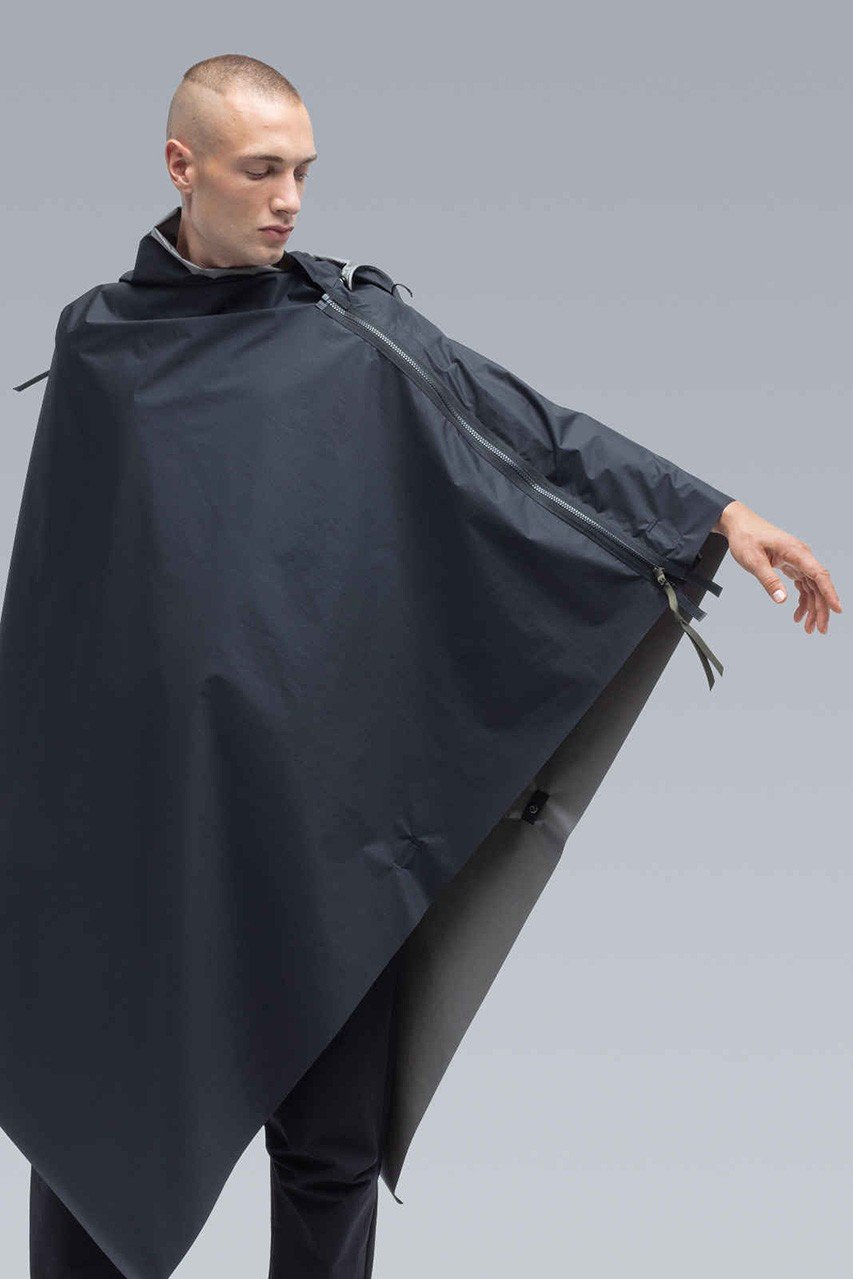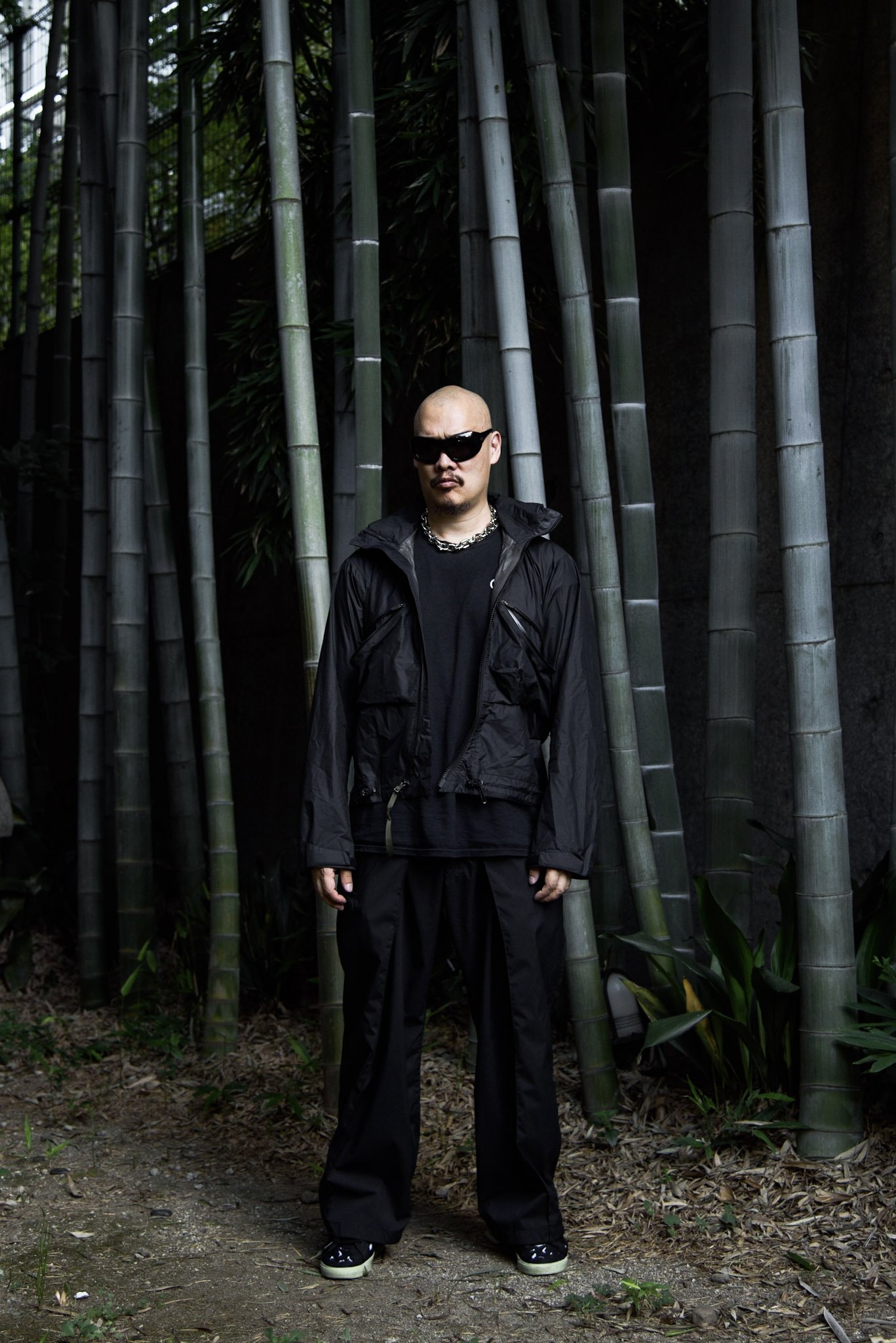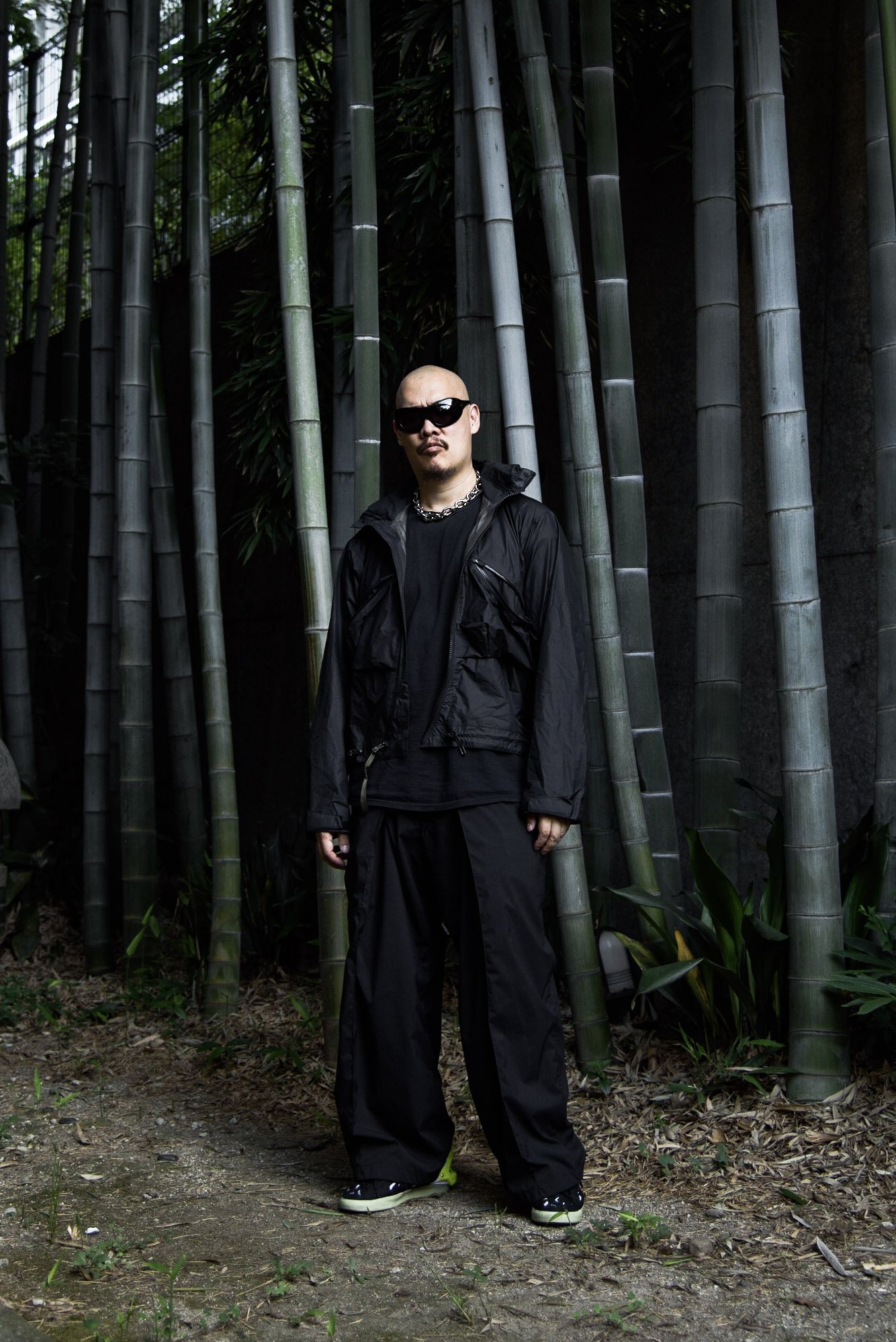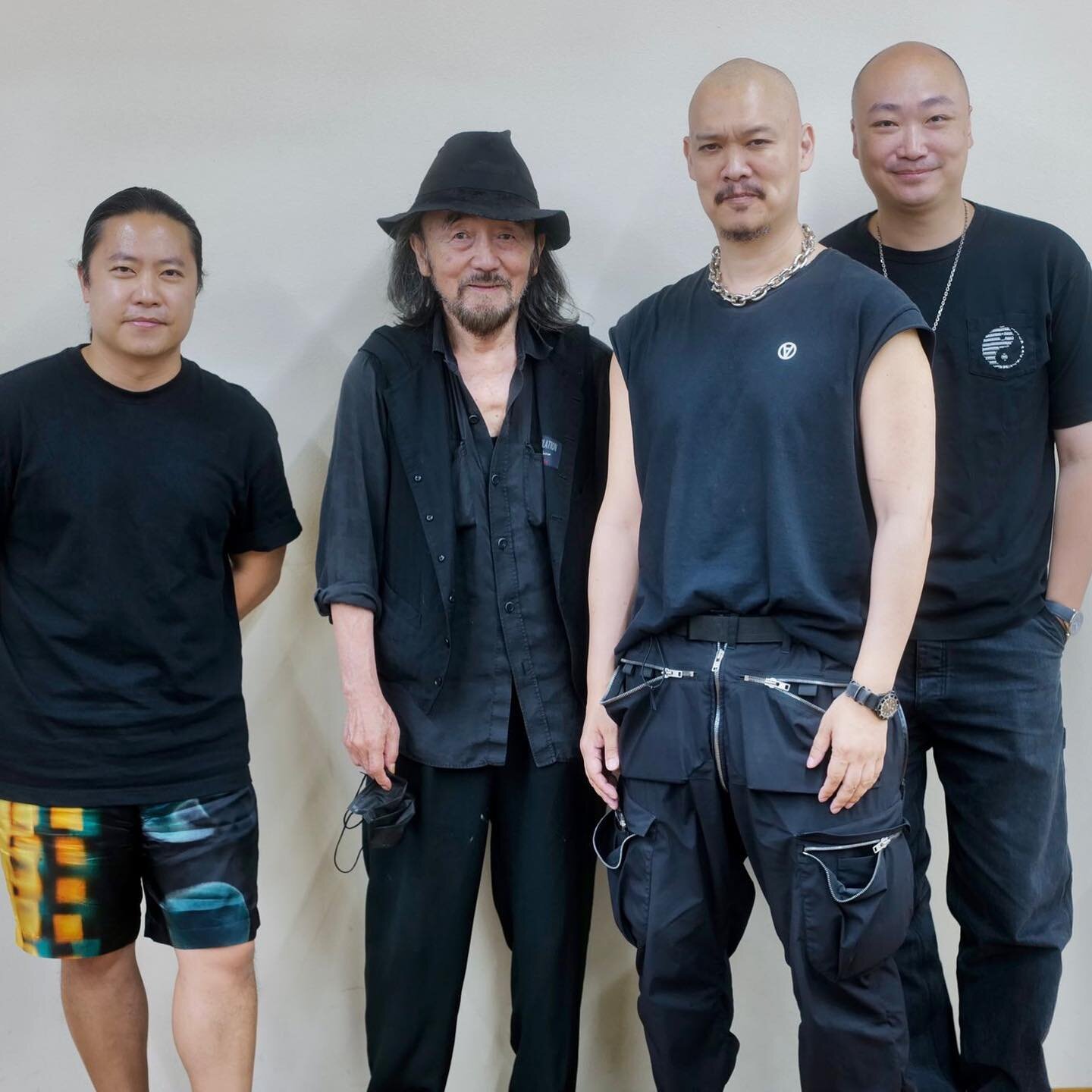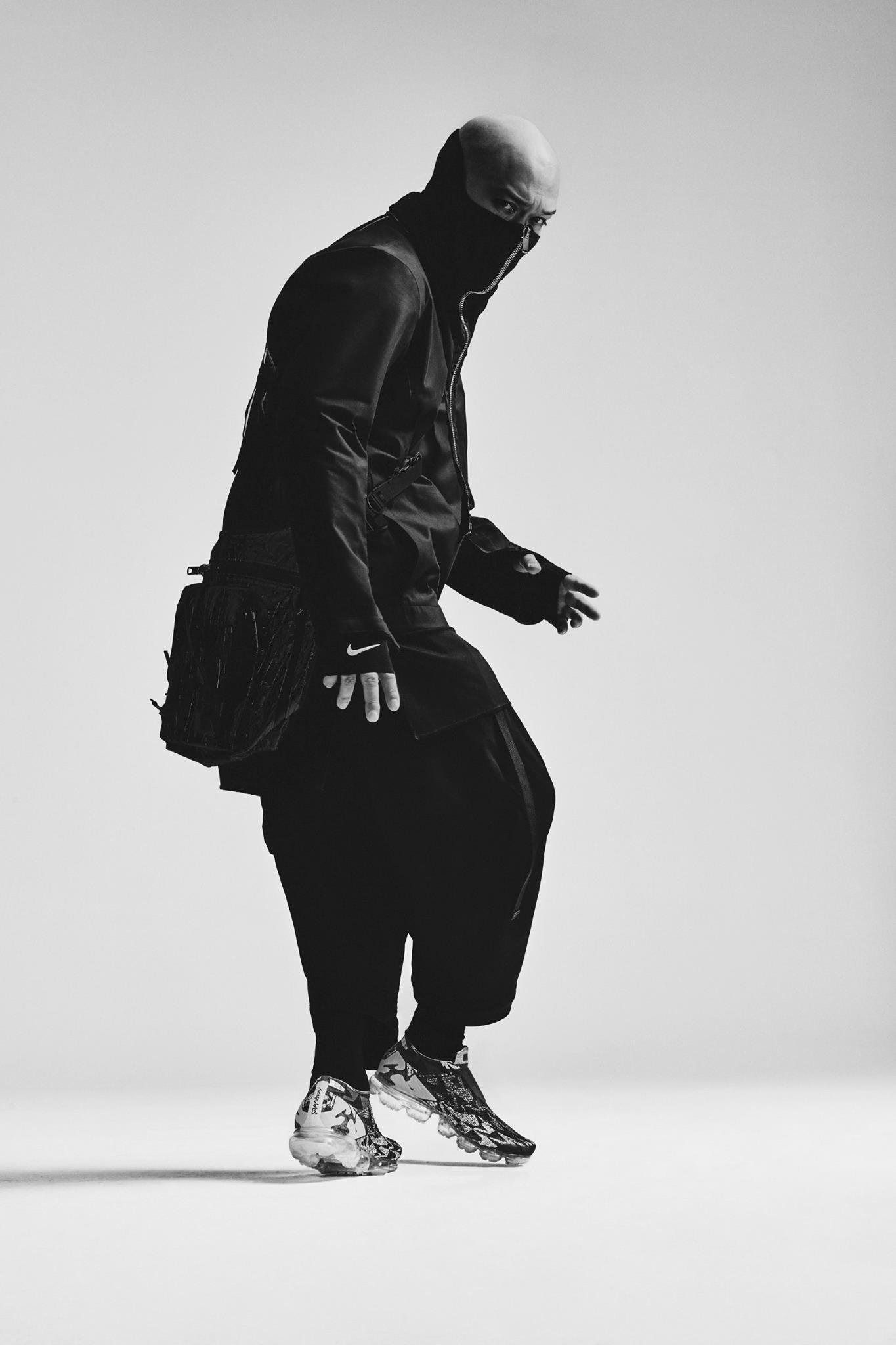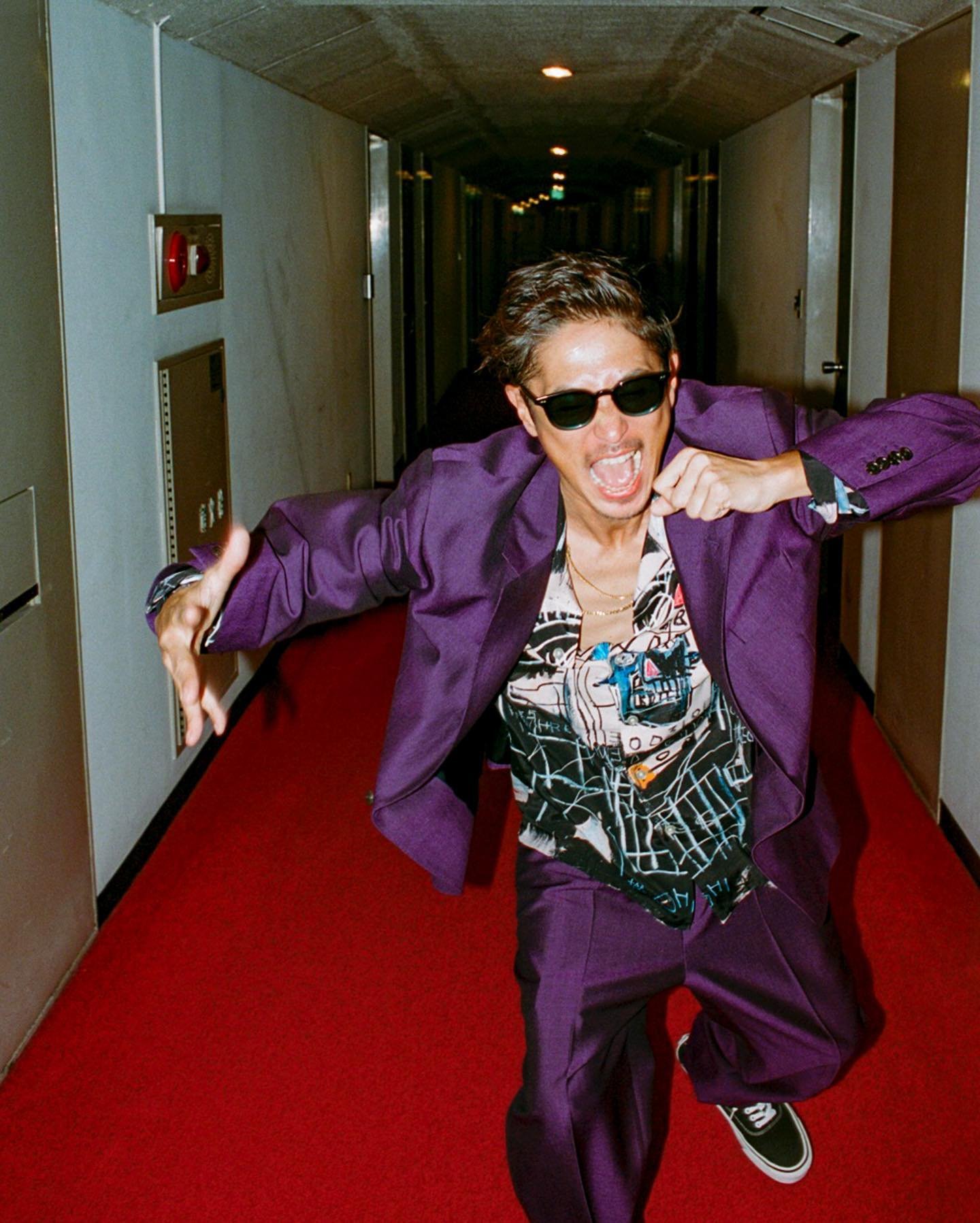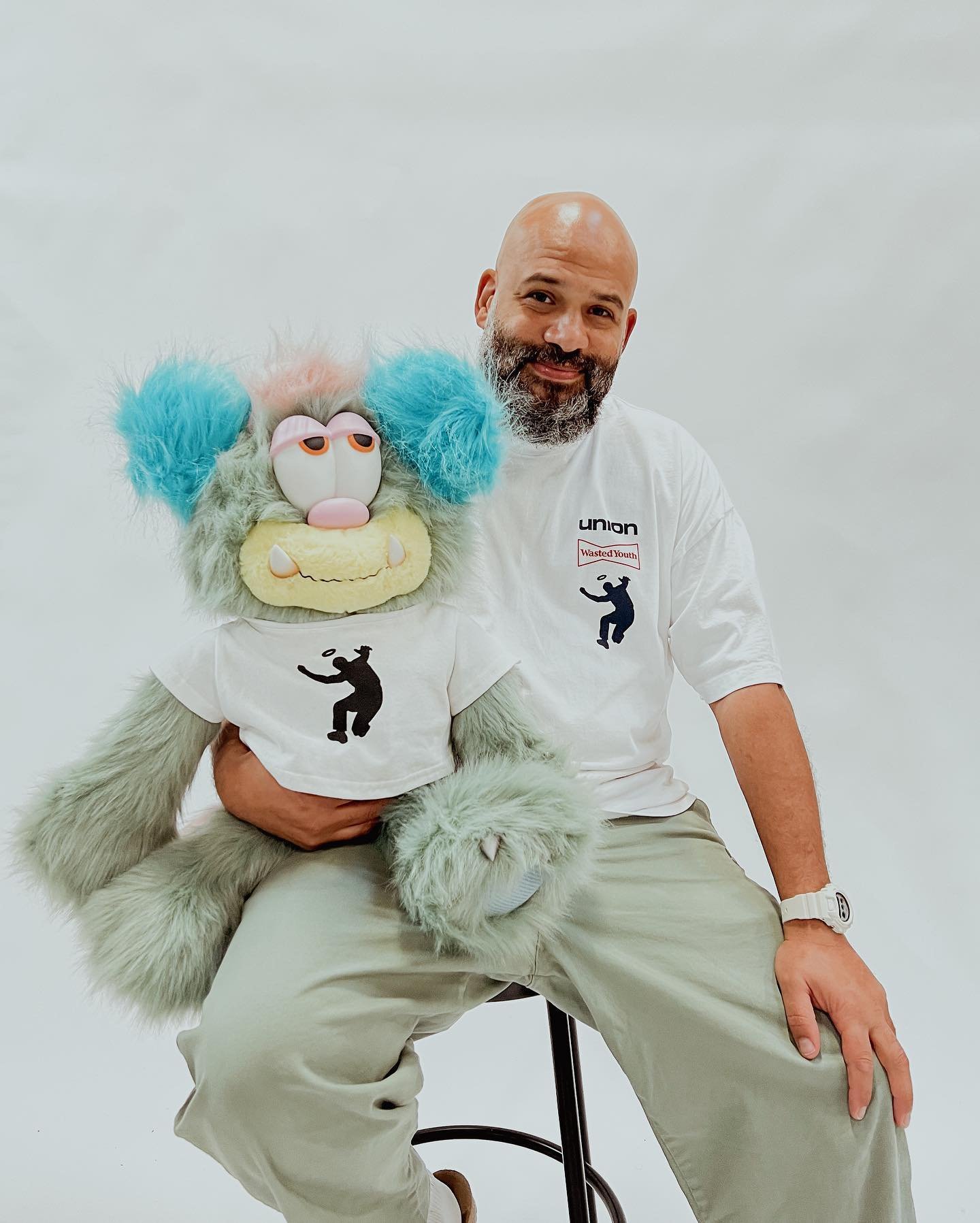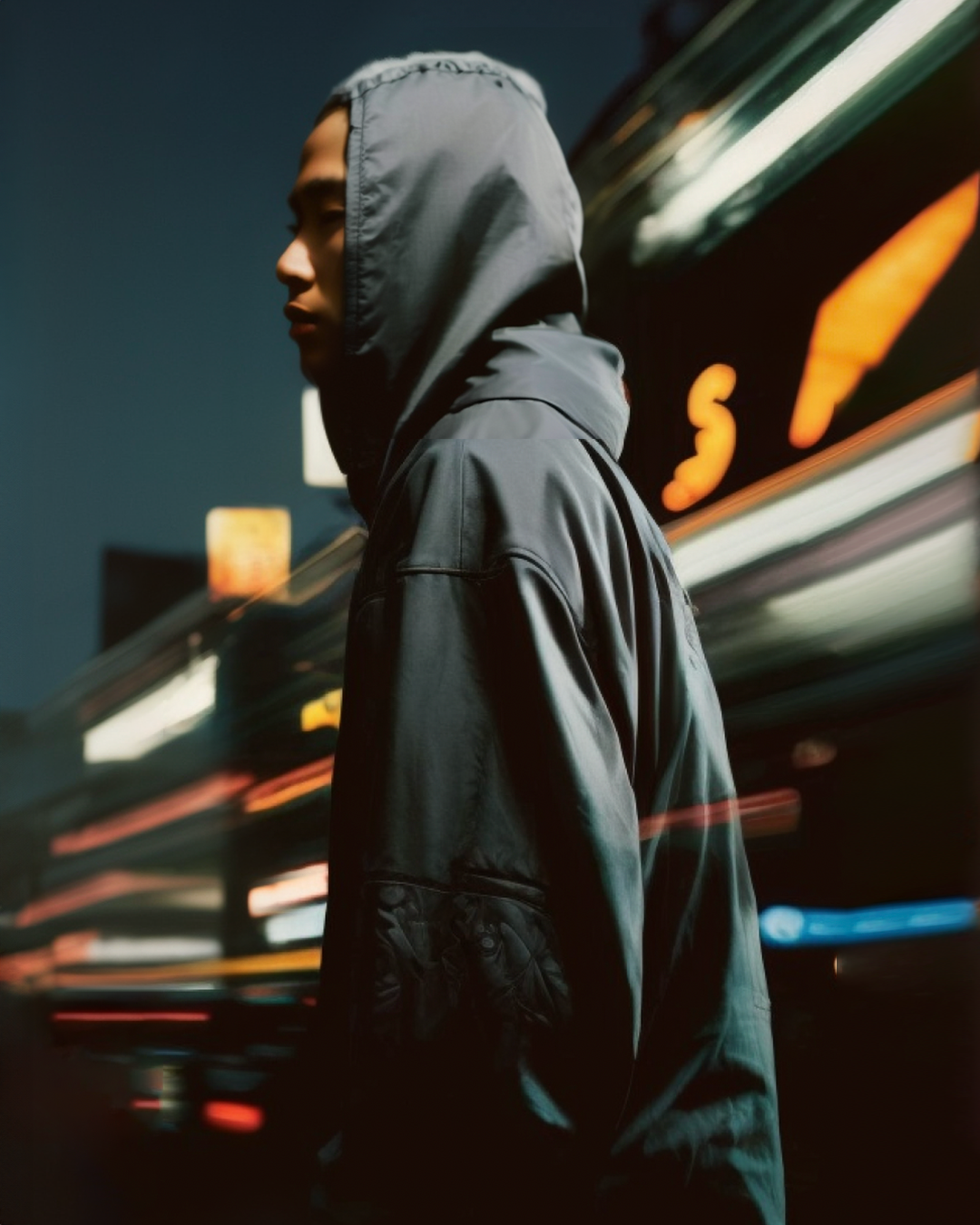Errolson Hugh: The Final Boss of Fashion
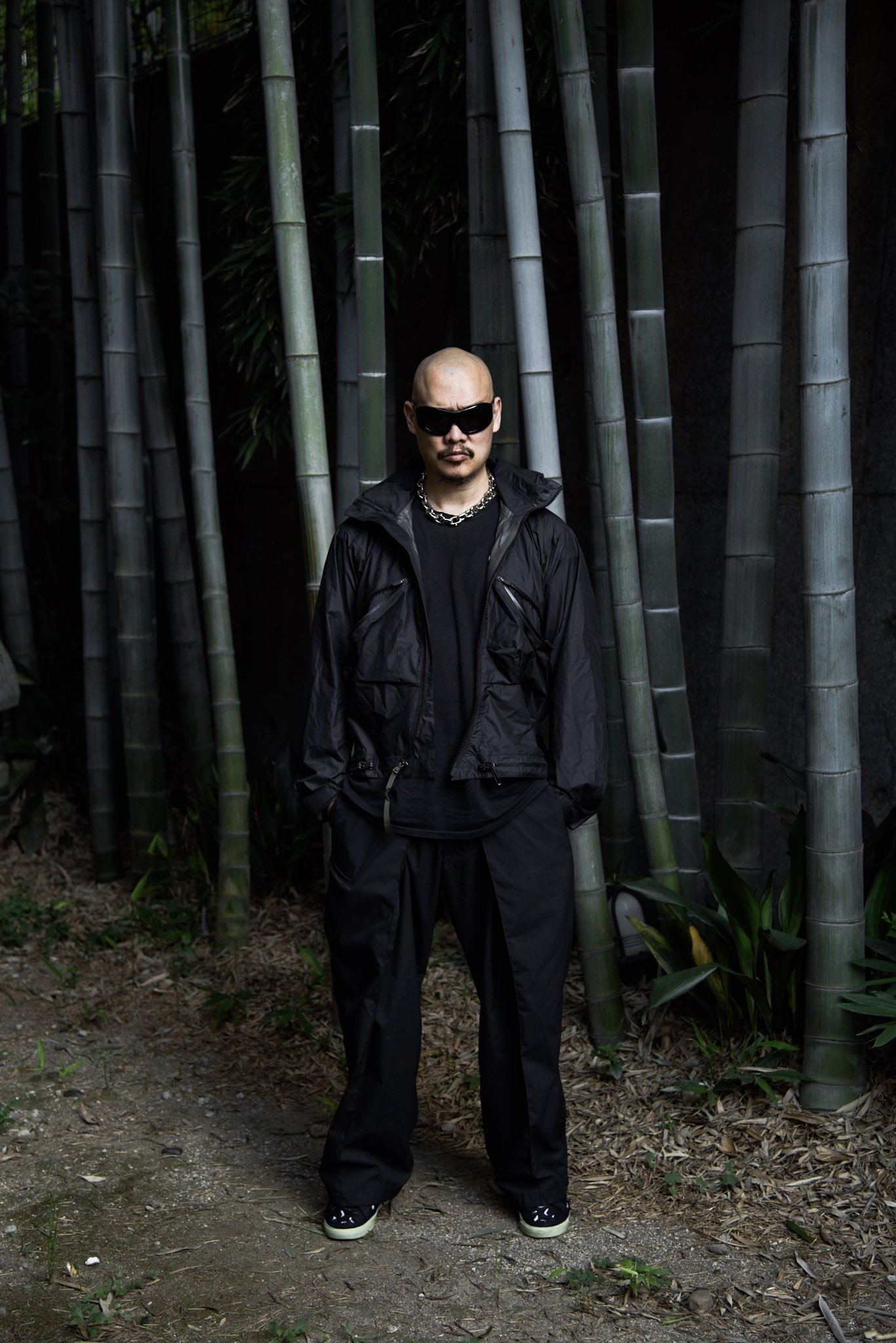
The year is 3022. Neon lights and holograms provide a sensory overload as flying cars fill the sky and a blur of fast-paced industrial techno fuels the streets' nightlife. Like a story straight out of William Gibson's novel, civilisation now sits in a space between a brighter future and a darker tomorrow.
Everyone is dressed head to toe in acid-rain-proof jackets, pants that allow for unlimited maneuverability on the rooftops of the utopic city, and sling bags able to contain all essentials and seamlessly integrate with the jacket for accessibility and comfortability. And it’s all designed by one man: Errolson Hugh.
Of course, this future is a fantasy world, but one that could not be too far away from reality. ACRONYM, the Berlin-based techwear brand that laid the foundation of modern functional attire could quite easily fit into a cyberpunk future, and Errolson Hugh, co-founder of this ultra-functional brand, could quite easily be the protagonist [or antagonist] of said story.
S25-PR-B
J1W-GTPL
Never seen wearing anything other than an ultra-functional fit, dressed head to toe in blacked-out battle armour-like fashion, Errolson Hugh is the final boss of the fashion world. Based in Berlin, but raised in Canada, the paragon of techwear is the co-founder of ACRONYM [along with Michaela Sachenbacher] and one of the driving forces behind the now ultra-functional apparel genre. Initially running a creative agency based in Munich, primarily working as an art director and designer for active sportswear brands within things like snowboarding and biking, they would venture into their own space eventually to create the holy grail of techwear brands.
SAC-J6010
A Godfather of the scene, Errolson has not only created a brand which already can tackle the future with ACRONYM, but has also been a pivotal part of many other brands' innovative development such as Nike and their revival of their ACG line, Stone Island’s Shadow Project, Burton and Herno Laminar. The mastermind, through his knowledge and obsession with functionality, provides us with a lens into the future and makes it accessible in the present day.
Nike x Acronym Presto Mid
ACRONYM, founded in 1999, is a pillar of success and a testament to the dedication and craftsmanship that this type of clothing requires. On a constant quest to better itself, ACRONYM’s focus is on making our everyday lives easier. In a world in which technology is consistently trying to make our lives more convenient, it only makes sense that our clothing can do the same. ACRONYM’s clothing works harder for us, lasts longer, and are things we can trust to do exactly what they need to do and so much more.
From detachable hoods and jacket slings for ultimate access in a pinch, to more elaborate features such as the ‘gravity pockets’; an innovative pocket in the sleeve which snaps open internally, and then the object inside, usually a phone or similar-sized object, uses gravity to fall into your palm for seamless access. To list all the features that an ACRONYM piece provides would require an entire article in itself, but each one is thought about in incredible detail in order to make every aspect of the garment synergise with your everyday life.
P45-GTPL
In a world where fast fashion and consumerism is consistently coursing through the veins of our society, a brand such as ACRONYM is bent on enabling the wearer to do more with their purchases. To purchase an ACRONYM piece is a big commitment, being at the price point of most high-end luxury brands, but what you receive with an Errolson product is not the fancy embossed tags or thick, plush dust bags. ACRONYM in fact scraps all of this, opting for off-the-shelf unbranded zip lock bags to hold their $1,500 jackets. The price you pay is all in the garment itself: in the research development, the technology of the garment, and the virtually bulletproof materials used throughout the range.
CP4-WS 2L
Errolson’s impact in techwear, and fashion in general, will echo for generations, inspiring countless young designers and brands. His work for ACRONYM and many of the various brands he helped access the future with is a testament to the level of quality the products he creates provide. And Errolson does it all his own way. Never following trends, with an always unorthodox approach to usual marketing and sales.
With this being said, Sabukaru Online offers our readers invaluable insight into this legend. We sat down with Errolson to discuss his life, his inspirations, his design philosophy, and his recent visit to Tokyo.
First of all, thank you for taking the time today. Can you briefly introduce yourself to the sabukaru network?
My name is Errolson Hugh, the co-founder and creative director of ACRONYM, which is a brand that we founded in 2002. We do technical performance meets fashion. I guess the kids are calling it techwear these days. We’re based in Berlin.
How would you describe your brand to anyone that might’ve never seen or heard about you?
I’d make them try it on and ask them to let me know what they think in a few months [laughs]. I always say you can’t really understand ACRONYM unless you’ve lived with it for at least three months. Part of ACRONYM translates in photos, and other parts in text, but I think the biggest reason why we’re still around after so many years doesn’t make sense unless you’ve lived in what we make.
P25-DS
You’ve previously mentioned how you grew up in Canada and how it’s an isolating place for someone in fashion. What sparked your interest in fashion, and what pushed or motivated you to explore further than what was Infront of you?
The first thing that really sparked my interest in fashion was this Karate gi [traditional karate clothing] I had when I was 10 years old. It was the first piece of clothing I had where I realized wearing it enabled me to do things I can’t do with normal clothes. That was sort of the beginning of my quest for making pants you can kick people in the head with [laughs].
J91-WS
I knew from a very early age that I wanted to design things since both of my parents were architects; my mom was an interior architect, and my dad was a traditional architect. They had a small practice, a humble place, and they didn’t have money for a babysitter, so my brother and I grew up in the studio. We had our own desks and spent a lot of our free time there, so it seemed natural for me to want to be in design.
I grew up in this small place in Alberta, which is like the Texas of Canada, and I wasn’t exposed to much fashion growing up since the internet wasn’t around at the time. If you can imagine, oil, cowboy hats, and rodeo were the things back then, and hockey was pretty much the only entertainment around. It was freezing cold all the time, and I remember walking to school was sort of a 10-minute survival adventure, where I had to stomp my feet to get back the feeling in my toes, and crack my scarf off my face because it was frozen solid [laughs].
ACRONYM x Be@rbrick
I also remember my guitar teacher giving me a copy of The Face magazine back in the 1980s (laughs). It started with that, i-D and my dad's copy of Interview magazine in 1985 with Madonna on the cover. That was sort of the first time I realized the existence of subcultures, coming to understand that there was cool shit going on in the world, but just not where I was at the time. There used to be this one store that got a copy of all the magazines I wanted to read every month, so I went there every day to check if a new issue was out. That was sort of my introduction to what we know as culture today.
Martial arts being a big influence for the clothes you make, how has it helped not only in the direction of ACRONYM but also in navigating your own life?
I’ve learned a great deal more from Karate than any other type of education I’ve gotten. I talked to my brother Harlan about what made it so good, and we concluded that Karate is like a microcosm of reality where everything is as it ideally should be. It doesn’t matter who you know, who you are, or where you come from, because whatever you put in is what you get out of it. The effort you put in directly correlates to the result.
As a young person growing up in a place where there were no systems that really supported my identity as a creative, it was a huge deal realizing that it was down to me to affect the outcomes. My Karate instructor, Sensei Joseph Rempel, used to tell me to repeat what I learned 10,000 times at home. It sounded like a joke to me back then, but he was actually giving me advice on how to succeed in life (laughs). So, from learning the most basic lessons about work ethic or agency, to understanding higher concepts about how the human body works, Karate prepared me.
SP28-DS
It’s very reminiscent of how ACRONYM as a brand is constantly bettering itself, reiterating past products and continuing to improve them.
It’s funny, although it’s more obvious now since I talk about it all the time, but when we started ACRONYM, we were still figuring out what we wanted our brand to be about. We knew what we were doing technically because we were taking contract work from other people, but we weren’t satisfied, sometimes even hating the end results. So, when we sat down and talked about what we wanted to do, we instinctively went about our work, but it wasn’t until three years into the brand that my dad pointed out that we were doing “martial arts stuff,” and I was like “Goddamn, he’s right.” [laughs]
NG4-PS
Besides martial arts, were there other cultural influences growing up?
Movies and music were definitely big influences since as I mentioned, fashion and culture as we understand it now, weren't really accessible where I grew up. Like I never knew about Public Enemy until I took a trip to Sydney, Australia, and I only found out about MTV on a trip to Chicago. I remember being so mad about not knowing what MTV was, even though it had been going on for many years at that point (laughs).
I loved everything about science fiction, so movies like Star Wars, Tron, and Blade Runner were some of my favorites for their stellar world-building. Come to think of it, those sorts of films were probably some of the first encounters that informed my understanding of what a brand is. Somewhere between the storytelling constructs found in these sci-fi universes, and growing up in an architecture office surrounded by Bauhaus books and Walter Gropius texts, I found inspiration and was informed as a creative person.
Everyone speaks of you highly as one of the friendliest persons in fashion, but how do you maintain as such in an industry often regarded as one of the most superficial?
I have no idea [laughs]. I guess even though I’ve been in fashion for the last 20+ years, it still feels like I’m at the beginning. I just know I have so much to learn, so I still feel the same way I did when I was younger. Plus, you never know who you’re really talking to and what you could potentially learn from them.
I suppose it also goes back to my Karate days where the nicest guys were often the most dangerous. They had nothing to prove [laughs]. When you’re sparring with the black belts, you never get hurt because they’re in control, while the white belts, on the other hand, are still mostly battling themselves.
Let’s talk about your work with Hideo Kojima. From being featured in a video game to designing and releasing clothes inspired by the same video game. Given the chance, which franchise, old or new, would you like to be part of now?
Firstly, I’d probably like to make my own video game, but if I had to be put into one, I’d say I want to be in Metal Gear Solid 2: Sons of Liberty [2001]. It's one of the games I played endlessly when I should’ve been working [laughs].
J1A-GTKP
Are you a big gamer yourself?
No, not really, but I have always been into the aesthetics and the world-building aspects of them. In that regard, Kojima games are always in a league of their own. There are so many more games I’d like to get into, but due to time constraints, I just can’t. I still need to finish Death Stranding (2019) [laughs].
You’ve been referred to as the “final boss” quite often, but if you were to become a final boss in any video game, which would it be?
The hardest one, so it’s Elden Ring [2022] right now, right [laughs]?
You’ve mentioned films being a big influence growing up, but were there any that you were particularly obsessed with?
I was probably most obsessed with Tron [1982] because I watched it when I was super young. I remember before seeing the film, and even after watching it, I would cut out the ads from the newspapers, every single day [laughs]. I was obsessed with all the different formats the logo had because they were so cool. Funny enough, finally watching the movie didn’t even matter since I was so into the aesthetics and the technology that went into it [laughs].
J1L-GT
I also remember 1989~1990, I was a college student in Toronto, and someone had just come back from Japan over the break with a bootleg copy of Akira [1988]. Me and five other guys went to the media room, stuck the VHS in the deck, and we all sat down and watched it with no subtitles [laughs]. None of us spoke Japanese, so we had no idea what was going on in the film, but we were all speechless, watched until the end, hit the rewind button, and watched it again. That was a funny moment in hindsight [laughs].
Are there any differences between designing clothes for movies/video games and commercial fashion? Or have you reached a point where you’ve created an unlimited space of creativity?
No, I’ve definitely not reached an unlimited space of creativity yet [laughs]. The main difference between doing something for a film and anything else is the timeline. Movie schedules are blisteringly short. It's difficult for us to work with films because they just don’t have the lead time. When we were asked to do Ghost in the Shell [2017], we sort of agreed on using existing products, but the studio couldn't even tell us who the actors were, so not even knowing the size of the people we were dressing, we ended up not being able to do anything.
Hobbs and Shaw
As far as how we tend to do things, we do exactly what we do when creating regular clothes. Designing for Deus Ex: Mankind Divided [2016], in particular, we initially intended to send in a selection of sketches, but at some point, we realized they didn’t look or feel real. The studio also didn’t like it, and the art director wasn't getting what they wanted from us, so we switched approaches, designed an actual garment, and made a prototype. We then sent a photo of me wearing the prototype and the design was approved.
Deus Ex: Mankind Divided
Learning from this, we now tend to design things exactly the way we would in real life, and Death Stranding was no different. We designed the base layer Sam wears in his room by imagining him as a real person, in a real environment, with real demands.
Death Stranding
Having spent more time in Tokyo recently, visiting the city as often as once a year these days, what makes the city and the people special to you?
Everything [laughs]. One of the most fascinating things about traveling is seeing how very small cultural preferences are, whether it’s the tendency to be on time, or how words may be understood literally versus contextually. Even though these can seem like small intangible things, they grow and materialise, and eventually crystalize as a city. Everything tends to be informed by the same core set of behaviours throughout a culture or a region. Of course, all these things are influenced by time, temperature, or climate, but to answer the question, I can’t [laughs]. I don’t have a simple answer.
What does a typical week in Tokyo look like for you?
It’s a bit different since I haven’t been in Tokyo for the last three years, and I’ve pretty much been going from meeting to meeting this time around. I’ve just been trying to catch up with everyone and saying hi. But I'm usually super jet-lagged, so I'm either up early and then crash early, or I crash really early and then I'm up all night. There's no telling really.
J96-GT
Are there any hotspots that you can recommend people to visit when in Tokyo?
No, not really. I tend to go with the flow since I end up aimlessly walking around Tokyo, more so than in other cities. Partially jetlag, but also because Tokyo is sprawling and vast yet extremely walkable. The sheer density makes it so that there’s always something to discover around the next corner. Tokyo is also just visually stimulating, so I end up doing a lot of night-time tours in random parts of Tokyo, which is why I don’t have any recommendations since I couldn’t take you there myself (laughs). I just try to get lost.
SAC-D6012
You recently met up with Yohji Yamamoto. What are some of the things that you look up to in great Japanese designers like him?
It’s interesting because Yohji is almost 80 years old now. I went to The National Museum of Modern Art with my friend NESM yesterday, where we saw an exhibition by Gerhard Richter, who is 90 years old. There was one section of graphite drawings. Looking through them, we realized they were from last year and that they were drawn on consecutive days. And there were a lot of them. It was so interesting to see a kind of daily progression in sequence.
Erollson Hugh with James Jean [left], Yohji Yamamoto [Middle], and Calvin Chan [Right]
With Yohji, when I think about the amount of stuff he’s done over the years, it’s the same thing. The day we met, he went to a fitting at 5:00 pm with his patternmaker. Thinking about the number of times he’s done that over his career makes me appreciate the level of focus and dedication he still has to this day. It’s incredible to think that he’s still doing what he used to do in the beginning of his career, because it’s the same with any fashion design studio on earth; that fundamental part of the work is still the same. No matter the scale of his business, nor his reputation as a designer, the fact that he’s been doing the work for that long, is simply inspiring.
Errolson and Yohji Yamamoto’s dog, Rin.
We’d imagine you’ve met most people in Tokyo, but who are some that you’ve yet to and want to meet?
Nobody comes to mind, to be honest [laughs]. I also tend not to think about things in that way. Even without thinking about it or planning it, I feel like I run into the people I need to, at some point. I also realized that if someone’s work truly resonates with me, more often than not, my work will resonate with them as well. It's beautiful how creativity can connect people regardless of culture or discipline. I’ve been very fortunate to meet a lot of people whose work has inspired me as a young person.
ACRONYM First Edition Kit [2001]
Are you a fan of anime/manga? What are some of your favorites?
I really like Blame! [1997-2003] by Tsutomu Nihei. I love that there’s almost no dialogue and how amazing the style is. I was really into Eden [1997-2008] by Hiroki Endo for a while mainly because I liked the knife-fighting scenes [laughs]. Obviously, Ghost in the Shell and Akira in manga form are truly incredible. As far as anime, Yoshiaki Kawajiri's Ninja Scroll, Koji Morimoto's Genius Party Beyond, and Takeshi Koike's Redline are some of my all-time favorites.
Blame!
Eden: An Endless World
If you could choose any setting to live in, whether a futuristic cyberpunk city or back to the middle ages, where would you want to be?
That’s a good question. One of the problems I have with living in a futuristic setting is that so much of it is portrayed as dystopian. I think it’s a lot harder now to imagine a “protopia”: a word my friend Monika Bielskyte refers to as a society that’s incrementally better than the one we currently reside in. Even the word “utopia” has nightmarish associations these days.
It’s peculiar that the imagination of a better future is not prevalent in our culture, but that’s sort of part of our job as designers: portraying the alternative to surveillance states or climate-decimated societies. Maybe it’s a degrowth economy, or going back to indigenous cultures and studying how they operated, which is why I think that Black Panther’s Wakanda is such an interesting portrayal of civilisation further along than ours.
F1-T-B
Functional clothing has become the hottest thing more than any other time in history. As the godfather of techwear, what’s your take on the recent surge in popularity?
I think it’s great. I remember having a conversation with Michaela, the co-founder of ACRONYM, back when Stone Island and Arc’teryx approached us, asking if we could do what we do for their brands. “Do we want to give them our secrets?” Probably not, but we realized that they were eventually going to figure it out on their own anyway, so we thought we’d rather be inside these conversations and help steer their direction even.
3A-5
By 2006, we figured the industry was going to evolve in the direction we’d been taking ACRONYM in because, for us, technology was never the end goal. Technology and functionality are subordinate to quality in our view. High performance shouldn't just mean high technology. It should mean fit for purpose, well made, and durable. I’m just as into silk and wool as I'm into GORE-TEX fabrics because, in some contexts, these materials are the most suitable.
J99U-WS
Performance for its own sake is not really what we’re about, but we think the industry has to adopt function-led philosophies, especially with dwindling resources, late-stage capitalism, and hyper-individualism becoming more and more tangible threats across the world. People need to go back to buying less and opting for longer-lasting products. It wasn’t that long ago when people got their father’s suit refitted for themselves. We’re talking about a 30~40-year life span for a single garment. That’s a very different approach to fast fashion brands that we’ve grown accustomed to. I think functional clothing's popularity is a natural evolution and generally a positive thing. I also think it’s just the evolution of our relationship with technology in general wherein we expect things to do things now.
R O G ZEPHYRUS G14–ACRNM
You’re seen head to toe in ACRONYM almost 99% of the time, but If there was just one fit you could wear for life, what would it be?
If it was one fit for life, it would definitely be made up of ACRONYM products [laughs]. It would probably be our P38-E pants, J104-GT jacket, and LA6B-DS shirt, which is a completely matte black look.
Actually, I test almost everything we make, including prototypes and sometimes even products I'm not personally into, so I end up wearing ACRONYM most of the time. When I get bored and wear other brands, I usually gravitate towards things that are completely opposite of what we make, for example, Japanese brands like KIDILL or WACKO MARIA.
Wacko Maria
KIDILL
P38-E pants
LA6 shirt
J104 jacket
It’s not often we see the designer featured in campaigns of their own brand, but is there any reason you choose to be the face of ACRONYM?
That actually didn't start out on purpose. It just so happened that I fit the samples, I was always available, and I was cheap [laughs]. We didn’t have money when we started, and it’s been that way ever since [laughs]. I felt weird about it for years, especially when people questioned us about it, but we literally couldn’t afford to do anything else. At some point, the narrative flipped from it being uncool, to it being genius, but it was never a grand strategy or anything like that.
F1-T-A
J84-S
J93-GTPL
Japan’s weather has been crazy for the past few years. From being scorching hot to dampening humid, what’s ACRONYM’s answer to extreme weather like this?
Venting is definitely a good solution, although all the stuff we produce is meant to be used for all seasons. We did a really good pair of shorts for our Summer 2022 collection, and we’re definitely going to be doing more of those.
SP29-M
ACRONYM garments are built as a layering system, but it’s something I’ve been thinking about a lot since Berlin reached 38 degrees Celsius, too. It’s quite crazy, especially since there’s no air conditioning in Europe.
Other than featuring in your own campaign shoots, other aspects of ACRONYM are quite unorthodox, as well. From having no brand social media page to not having an official flagship store. Are these conscious decisions you made or sort of how things fell into place?
It’s sort of how things fell into place because we didn’t realize what we were doing was fundamentally at odds with the industry. Even the fact that we don’t let shops mark our pieces' price down at the end of the season goes against 99.9% of the industry.
We realized over the years that although we can have our pieces hung next to brands like The North Face or Rick Owens, we don’t do anything the way either of those types of brands do. We’re doing our own thing and because of that, everything else has to be done our own way as well. Even when we try to do what everyone else does, it doesn’t work for us.
ACRONYM x Nike Air VaporMax Flyknit Moc 2
Often referred to as the godfather of techwear, if there was one thing you'd like people to remember you for, what would that be?
The bottle cap challenge [laughs]. Kidding, I don’t know. I’ll let history figure that one out.
As archives become more important in fashion history, how can we imagine the ACRONYM archive to look in the future?
We learned the concept of archiving when we were fortunate enough to visit Massimo Osti’s archive in 1995. Michael Dannroth, the owner of a German label called Sabotage - on which we had just started to work, had asked us to accompany him to Bologna for a meeting. We ended up in Studio Osti and were amazed to see the thousands of garments that populated the studio.
J16-GT
After seeing how Massimo Osti approached his work, we attempted to save one of everything we designed, both from our own collections and from all of the client work we had done. Our archive is stored in multiple locations now due to size and space restrictions. In the future, I hope we can centralize it in a single location once again.
From working with Nike to Stone Island’s Shadow Project and collaborating with Hiroshi Fujiwara on Burton, among the projects you’ve worked on, which ones are most proud of? Alternatively, which ones gave you the biggest headaches at the time?
There are obvious candidates for that, but I’ve talked about most of those before in previous interviews. Recently it’s been fun to see the Analog stuff come up from about 20 years ago. We worked on that with Greg Dacyshyn, the creative director of Burton at the time, and sometimes alongside Hiroshi Fujiwara as well.
Burton Analog Zeon jacket [2002]
Burton Analog ‘Blacks Ops’ Jacket [2005]
I do have to say, we started out as a freelance design agency fresh out of school, so we literally designed absolutely anything at all. Although we got to work on a lot of amazing projects and have been very lucky to be a part of them, we’ve also worked on just as many horrible ones. Luckily, we weren’t anyone yet, so no one will ever know [laughs].
We particularly love your campaigns, especially the one with Nike for the Vapormax. Are there particular favorites of yours that you’d like to share?
The Vapormax campaign was definitely one of my favorites. We worked with Danny Demers at Nike on that. In hindsight one of the most amazing things about it was that it ended up being three months from pitch to final edit and that the deck and the final edit were basically one-to-one. That kind of direct translation rarely happens. The whole concept was very fresh and unexpected, and being able to work with John Mayer has made it one of my favorite campaigns to this day.
Nike x ACRONYM Air Vapormax Moc 2 [2018]
The whole thing was almost frictionless. John had coincidentally reached out to Fraser Cooke a week earlier, the schedule worked out for everyone, and everything fell into place. The director, Carlos Serrao, and his wife, Monica May, the cinematographer, put on one of the best run shoots I’ve ever been a part of. I had zero stress, everyone was professional, and we had no delays, which is unheard of. The only thing that went wrong during the entirety of the project was that the tumbleweed wouldn’t tumble (laughs).
It’s the year 2050. What does ACRONYM look like?
Well, first I hope that we're still around and that the earth is still liveable in 2050 [laughs]. By that time, I hope we’re carbon negative, and live in a fairer and more diverse society. I think the way the entire world works right now is overwhelmingly incompatible with the reality of the planet we live upon, but I hope by that time, we’re doing the right thing. There are no shortcuts to bettering the world, and we need to take radical steps towards that immediately.
And to round things off, do you have any advice for young creatives?
Just go for it. Don’t waste any time, do your thing no matter what other people say; do the thing that only you can do. Everyone has their own unique experience in this world, and there’s something in your life or your perspective that will benefit someone else, even though you may not realize it now.
On paper there’s no purely logical reason that justifies making martial art-based technical apparel, but at the end of the day, the most unlikely things can turn out to be universally applauded and valued. Don’t worry about what anyone else thinks. Follow your instincts, and do the work. Go home and do it 10,000 times [laughs].
Thank you for your time!
Intro Text: Joe Goodwin
Interview by: Joe Goodwin & Casey Takumi Omori
Photographer: Tanase












